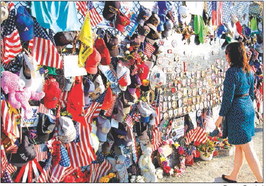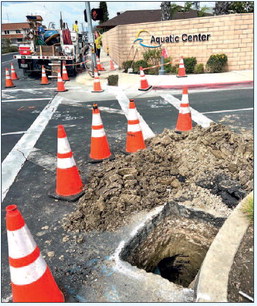A Field of Honor Forever


FLIGHT 93 NATIONAL MEMORIAL
by Donna Gambol
LW contributor
I lived in southwest Pennsylvania, just 25 miles from Shanksville in Somerset County. After 9/11, it became a regular stop when out-of-town friends came to visit.
The site of the Shanksville crash has been described as farmland. In fact, it is an area that had been surface-mined for coal. The replaced soil was relatively loose to a depth of 40-50 feet. When the jet crashed to the ground at a speed in excess of 500 mph, it burrowed right through the soil and was completely obliterated. Above ground, very little of the plane debris was visible.
Within days of the Flight 93 crash, folks began to gather at the site, which was quickly cordoned off with a perimeter fence about then a mile distant to keep spectators at bay. People wanted to express their sympathy and emotions; they tucked bits of memorabilia into the chain-link fence.
The tributes continued, soon the site became a tourist destination. Families of the victims organized, and with the help of Congressman John P. Murtha, pressure was exerted on the Federal Government to begin plans for a permanent memorial. Soon the site was under the auspices of the National Park Service, who after securing sufficient land, erected a 40-foot special fence and shelving structure to collect the tokens, stationing it at a distance above grade from the crash site.
Curatorial staff began to collect and catalog the items, which were carefully stowed until such time that a permanent memorial could be established. Within months, plans were underway to establish a national park. Interest in the site never waned; it grew each year.
The initial stages of the permanent memorial were completed in 2011, 10 years after the event. During that time, I served as executive director of the Laurel Highlands Visitors Bureau, responsible for tourism and travel in Somerset, Westmoreland and Fayette counties in Pennsylvania. All through 2010, I encouraged folks to go to the fence before the permanent site was completed, knowing that there would be a significant change in the area.
There was something raw about the original memorial site. It was always chilly atop that knoll, no matter the time of day or time of year. Always a crisp cool breeze, always the visitors, reverent, silent, slow-paced and reflective. Their tributes from the heart, painful and meaningful. It attracted folks from throughout the United States and the world.
The permanent memorial has a unique quality; the design is a simple marble slab echoing the flight path. Visitors continue to place personal tributes along the wall in various niches, sometimes against the wall beneath passengers’ names. Annually on Sept. 11, dignitaries come, and the families return for the tributes; crowds grow each year.
The memorial is now finished with the completion of the Tower of Voices. In 2018, a 93-foot tower was erected, and last year the “voices” were installed; 40 wind chimes representing the 40 passengers and crew.
Each year, on Sept. 11, Bells of Remembrance are tolled 40 times, starting at 10:03 a.m., once for each of the passengers and crew as their names are read, a tradition from the first Sept. 11 observance.

On Sept. 10, 2011, the first phase of the permanent memorial was dedicated at a public ceremony attended by then-Vice President Joe Biden, former presidents George W. Bush and Bill Clinton, other dignitaries, family members of the passengers, and thousands of others. Although Congress and private sources had funded the initial efforts for the park, money ran out before it was fully completed. At this dedication, former president Clinton and then-Speaker John Boehner announced the launch of a fundraising effort to raise the additional $10 million required to complete the memorial.National Park Service



